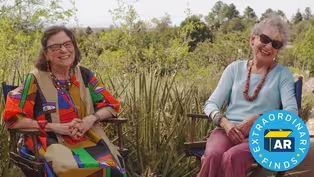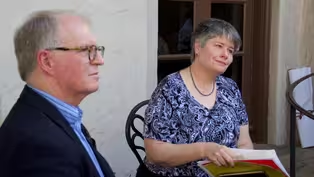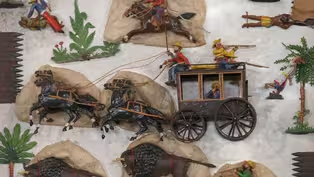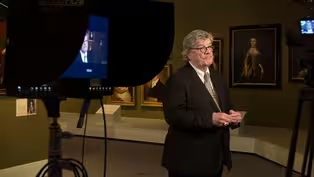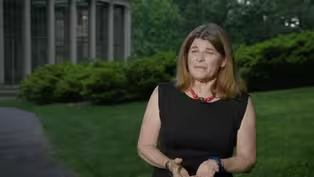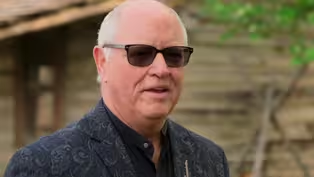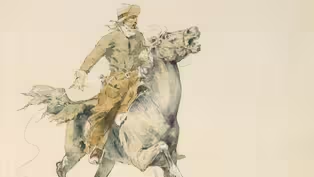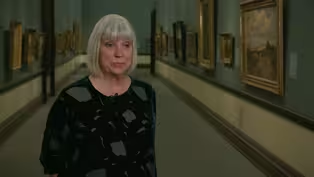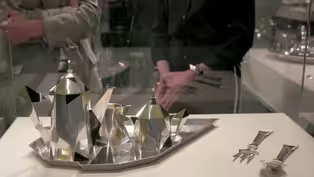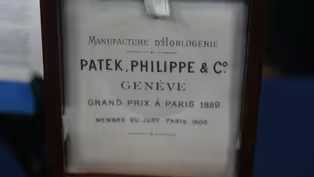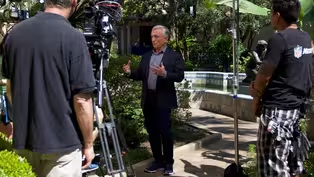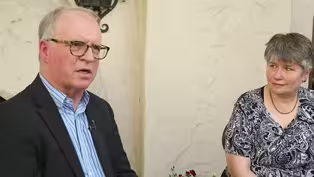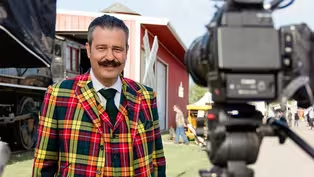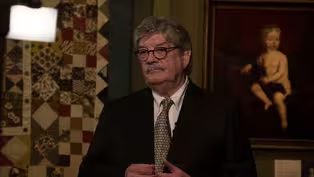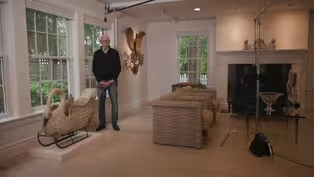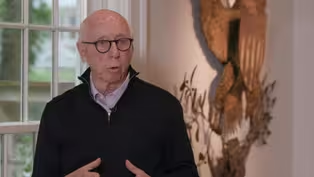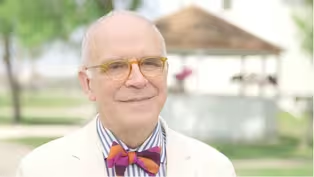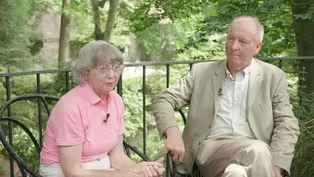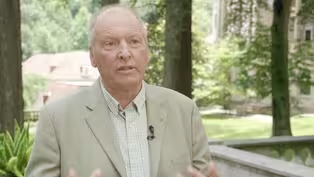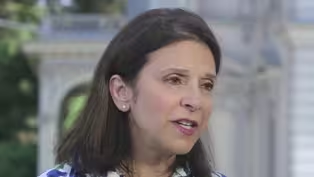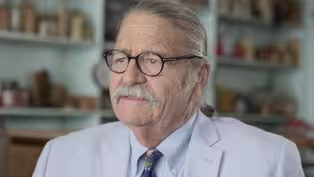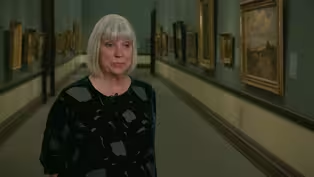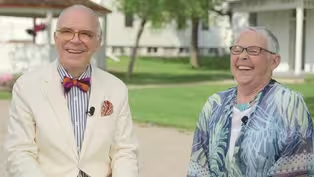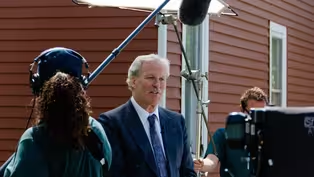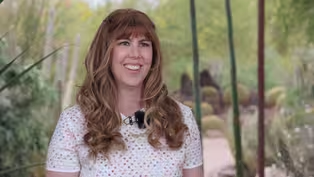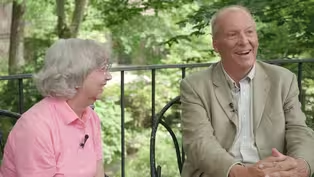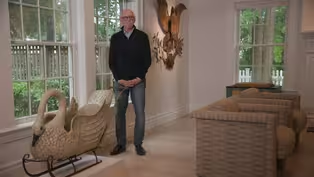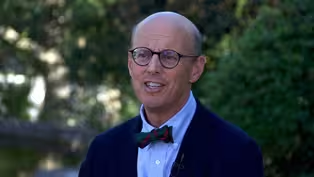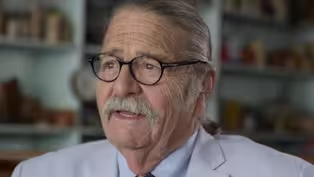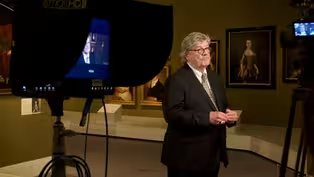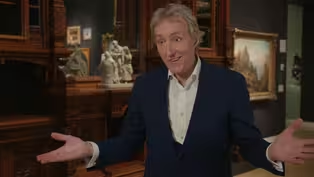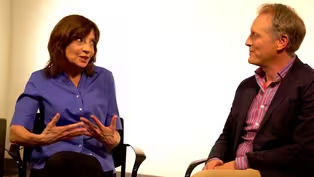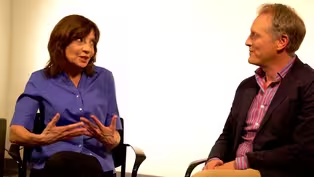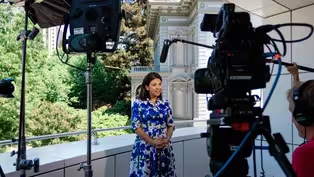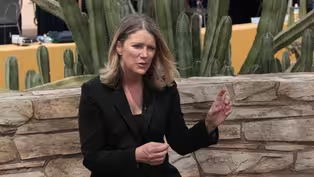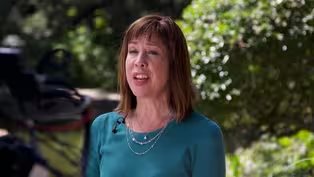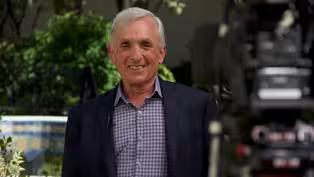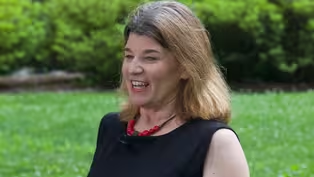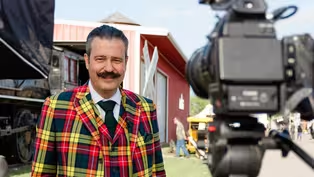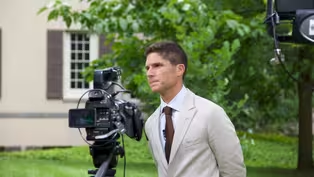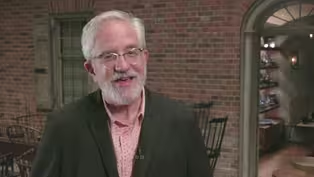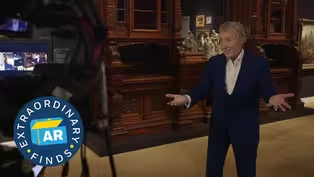
Extraordinary Finds
Season 23 Episode 24 | 52m 25sVideo has Closed Captions
Celebrate 500 episodes with an hour of pivotal moments, amazing finds, interviews & more!
Celebrate 500 episodes of ANTIQUES ROADSHOW with a multi-platform special that follows the pivotal stories behind some of the series’ most extraordinary finds through all-new interviews with longtime appraisers, guests, antique experts and more!
Problems playing video? | Closed Captioning Feedback
Problems playing video? | Closed Captioning Feedback
Funding for ANTIQUES ROADSHOW is provided by Ancestry and American Cruise Lines. Additional funding is provided by public television viewers.

Extraordinary Finds
Season 23 Episode 24 | 52m 25sVideo has Closed Captions
Celebrate 500 episodes of ANTIQUES ROADSHOW with a multi-platform special that follows the pivotal stories behind some of the series’ most extraordinary finds through all-new interviews with longtime appraisers, guests, antique experts and more!
Problems playing video? | Closed Captioning Feedback
How to Watch Antiques Roadshow
Antiques Roadshow is available to stream on pbs.org and the free PBS App, available on iPhone, Apple TV, Android TV, Android smartphones, Amazon Fire TV, Amazon Fire Tablet, Roku, Samsung Smart TV, and Vizio.
Buy Now
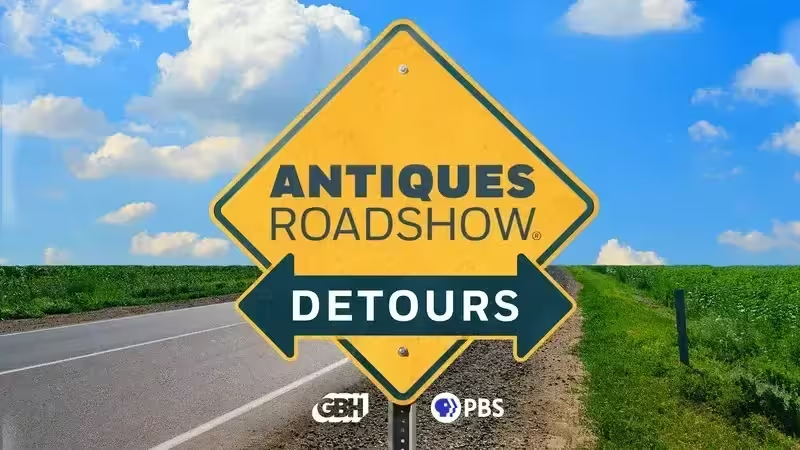
ANTIQUES ROADSHOW DETOURS
Ever wondered what happens to the treasures featured on America’s beloved ANTIQUES ROADSHOW after the cameras leave town? Host Adam Monahan tracks down the juicy afterlives of your favorite finds from PBS’s hit series.Providing Support for PBS.org
Learn Moreabout PBS online sponsorshipMore from This Collection
EXTRAORDINARY FINDS is a special unlike any you've seen before, revisiting some of our most amazing moments to answer the question: What happened next? We follow up on those fascinating stories with all-new interviews, appraisal updates and more!
Video has Closed Captions
Revisit some remarkable ROADSHOW finds whose stories didn’t stop even after we yelled cut! (52m 29s)
Video has Closed Captions
Learn what happens to more standout treasures after the ROADSHOW cameras stop rolling! (52m 23s)
Providing Support for PBS.org
Learn Moreabout PBS online sponsorshipMARK WALBERG: Ever wonder what happened to some of "Antiques Roadshow's" favorite treasures after our cameras left town?
When we first saw you, my heart started going like this.
AUCTIONEER (bangs gavel): Sold.
WALBERG: Find out in this 500th episode special, "Extraordinary Finds."
♪ ♪ "Antiques Roadshow" has made some incredible discoveries over our 24 seasons on the road.
APPRAISER: There's, like, one of four known in America.
You have one of them.
WALBERG: From our first-ever tag sale triumph in Secaucus...
The lady was asking $30.
She said, "You can, you can have it for $25," and I took it.
WALBERG: ...to a touching national treasure in Tucson.
When you walked in with this, I just about died.
I can't believe this.
WALBERG: And lots in between.
This is one incredible watch.
Oh, my gosh.
WALBERG: In this special episode, "Antiques Roadshow" reconnects with experts... We just couldn't believe it.
Here we are with an absolute masterpiece.
WALBERG: ...and owners... To this day, I can't really comprehend that much money for a screen.
WALBERG: ...to check in on some of our most extraordinary finds.
Thank you!
(laughing) WALBERG: When "Antiques Roadshow" first started traveling the country, most of us had no idea a single piece of furniture could be worth six figures or more.
Leigh and Leslie Keno were still relative unknowns, as well, but luckily, they turned up to educate us all about the value of one delicate and dirty card table we found in Secaucus.
LEIGH KENO: So it was 1997, and there we were, in Secaucus, New Jersey, and it's the last place that I would expect to see what we, what we saw, upside down, on a cart being rolled in by a lady, a schoolteacher from New Jersey named Claire.
I went to a garage sale.
How long ago was this, Claire?
This was about 30 years ago.
As we moved into our new house, I needed a diminutive table.
And I thought, "I think I know the shape and size."
She had gotten it one day when she was antiquing with a friend.
The friend actually said, "You know, don't buy that.
It's, it's so wobbly, it won't hold a lamp."
So she was actually considering not buying it.
When I saw this out in the yard, I thought, "This is a great thing."
It was pitch-black, it was a moldy mess, and the lady was asking $30, so... LESLIE KENO: $30.
I said, "But I only have $25."
I said, "That's all I have."
She said, "You can, you can have it for $25," and I took it.
LESLIE KENO: What you brought in today here is a Federal inlay mahogany demilune card table made by John and Thomas Seymour, very distinguished cabinetmakers who made some of the most distinguished and fine furniture for the very wealthiest families in Boston at the time.
We're very fortunate... You are, in fact, to have... the actual label...
Yes.
Of "John Seymour and Son."
Seymour and Son.
LEIGH KENO (voiceover): There it was, "John Seymour and Son, Creek Square, Boston."
And that's all we needed to see.
And, my God, we just, we just looked at each other, we just couldn't believe it.
Here we are with an absolute masterpiece.
I mean, one of the greatest pieces of Federal furniture I've ever seen.
This table, everything about it, even if it didn't have the label, says John and Thomas Seymour.
Really?
The quality is incredible, Uh-huh.
Did you try to clean it at any point?
Uh, linseed oil and turpentine.
I didn't even...
I didn't refinish it.
I wiped it off, and then I saw this.
And I took the dirt all off.
Well, Claire, luckily, you weren't a really great refinisher, because if you were...
I am, I am.
No, I'm joking.
She kind of looked at me, like, "What do you mean, I'm not a good cleaner?"
You know... you know.
And I said, "Well, because you didn't take all the grunge off."
If you'd cleaned it a lot more, you have taken a lot off the value, you know?
I figured.
Yeah.
So, luckily, it still has a nice old color.
See all the, all the dirt down at the bottom?
I love that, I love that.
It's left, yeah.
I just want to say, when, when we first saw you, my heart started going like this.
Feel it, you can feel it right now.
(imitating heart thumping) Mine did, too, yeah.
Leslie, Leslie looked over and said, "Leigh, is that what I think it is?"
And as we got closer, you had this upside down.
Yes.
And we saw that label.
LESLIE KENO: We saw the label.
LEIGH KENO: And Les went up to the label, and went, and he said, "It isn't, is it?"
And I said, "It is!"
LESLIE KENO: It really is.
LEIGH KENO: So it's really one of the most exciting moments I've ever had.
Really?
Les?
Yeah, absolutely.
One of the most exciting pieces I've ever seen.
And just to be here with this.
Yes.
Now, do you have an idea of what it's worth?
Or have you gotten some idea?
Oh, probably $20,000.
Now, I just said that.
LEIGH KENO: $20,000.
I think the estimate we're going to give you is, is going to top that.
Oh, yes.
I think Les and I both feel that this piece in the open marketplace, on a good day, would be in the range of about $200,000 to $225,000.
Okay?
Wow.
Now... $225,000.
$200,000 to $225,000.
Now, I want to say on a very, on a very good day, Are you going to write it down?
with everything in place, it has the possibility of bringing $300,000.
I don't want to get your hopes up that much.
But $225,000 isn't bad, I guess, right?
It's not bad!
Claire's mouth, I mean, it was just this, it was like...
It was, it was, it was priceless.
A really good policy on the "Roadshow" is that, is that, of course, we don't exchange business information with the person whose item we've just appraised.
And we said goodbye to Claire that day, and, and I never thought I'd see her again, really.
I think was within weeks after the appraisal, she actually looked up my brother's number and called him at Sotheby's.
And then the table went to auction.
I remember that day well.
It was January of 1998.
AUCTIONEER: Lot number 1440, the Federal mahogany card table, label by John Seymour and Son.
LEIGH KENO: I was sitting in the front row and the "Roadshow" cameras were to the far left, and Claire was also in the front row, way to the left, and it was pretty much every collector of American furniture in the audience that day.
So the feeling was one of excitement.
The bidding started and, it started at $200,000, $220,000, $240,000, $260,000, $280,000, $300,000.
And once it got to $300,000, it was...
I, I remember just looking down at Claire, and she was already just, just, you know, she had that look on her face like she did at the Roadshow.
But the number kept going up.
AUCTIONEER: $400,000.
MAN: Ten.
$410,000, $420,000.
30.
$430,000, $440,000.
50.
$450,000, $460,000.
70.
MAN: 80.
$480,000, $490,000.
I have $490,000, and it's still on the right side.
And down it goes, where you called it at $490,000.
(bangs gavel) Sold for $490,000, thank you... thank you, all.
(audience applauding, Claire laughing) WOMAN: Very good job.
Isn't that neat?
$490,000.
Wow, that's neat, yeah.
The buyer's premium-- in other words, the, the "BP"-- is the amount added on by the auction house to the hammer price, and it's paid for by the buyer.
Including the BP, the selling price ended up being $541,000, which was a world record for Federal furniture at the time.
So it's 21 years later.
So what's it worth today?
It's, it's a tough question, because the very, very best of American furniture has, has kept its value more than the middle-level stuff, and the brown wood has gone down.
The thing about this card table is that because it's rare, because it's labeled, because it has an original finish, and because it was made by probably the greatest Federal furniture makers in New England at the time, is it worth $350,000, you know?
Is it worth $300,000?
And I think there is someone that would, that would pay that.
But $550,000?
I don't know.
WALBERG: And now to a story about twins of a different kind.
Folk art fanatic Allan Katz reveals he is the owner of a mate to the adorable child swan sleigh we appraised in Milwaukee in Season 11.
KATZ: This story about the swan sled is really a story of, "What are the odds?"
Here we are in my home.
This is one of the cornerstones of our collection, and it is the mate to the one that was brought in to Milwaukee to be appraised by this lovely lady.
WOMAN: I got it at a rummage sale about seven years ago, and I paid about $35 for it.
KATZ: What we have here is a child's sled.
30 years ago, we would have said it's unique.
But about 20 years ago, another sled, same form, surfaced.
It was literally surreal.
I don't want to get too emotional here, but it was literally a surreal experience that this could possibly be happening.
When it comes to any appraiser, in any category, you absorb ten, 15, 20 things instantly.
It's called blinking.
And you take in all these, these objects.
So you look at the swan sled.
And having lived with it for as long as I did prior to the Milwaukee show, I know how the feathers are carved.
I know the unmistakable metal brace that's brought up the side of the wing.
Same exact curved metal that's in the other sled.
This indentation here, the way the wing is scooped out to give it dimension, those things are identical.
After that, it's click-click-click.
Everything just falls into place.
We don't know who the maker is, but we know it's by the same maker.
I bought this in the mid-'80s.
And... At that time I was single, and I was known for really paying a strong price, because I wanted people to bring me things.
I wanted to see a lot, I wanted to touch a lot.
It was part of my learning process.
A dealer who knew me purchased this from a dealer from Texas.
To the best of my knowledge, he paid $5,000 for this sled.
He came back to Connecticut, and he put a price on this that was very hard to take.
It was $40,000.
And I paid it.
It was a choke price, but I didn't regret it-- I've never regretted it.
It's the way the collecting world, the art world, works, because you're willing to pay it, you write the check.
Had I had a wife and a bunch of kids, I'm not sure that this swan sled would be here right now.
I would value it at somewhere around $20,000 to $30,000.
Oh, my gosh.
I could just cry.
I had no idea.
Wow.
It's a wonderful, wonderful object.
So I just thank you today for bringing it in to "Antiques Roadshow" and sharing it with us.
Well... Well, thank you so much.
I just never... had an idea it would be anything like that.
I would never, ever even consider selling it.
I mean, this is something I'll pass down to my grandchildren.
Flash-forward a couple of months, and she did reach out to me, as sometimes that does happen.
And she asked me to give her an insurance letter, which I did supply to her.
And then we really had no communication till after the episode aired.
And I find that to be the case sometimes, that the guest, they do like to have it in their possession when the episode actually airs, and have people over, family over, watching this episode.
And then there seems to be a release, that when you have something of this value, and the money could be put to good use, that, "We might explore selling it."
So she did call me after the episode.
She said, "Are you really serious about that price?
"And my grandchildren are going to college, "and we could use some money for the college fund.
"So would it be possible for you to represent the sled and sell it?"
And I said, "Absolutely."
I sold it to a private collector and can't disclose the exact price, but it's good to say that it was north of $50,000.
Ours is approximately twice the size.
This really resonates as a major piece of folk sculpture.
So in terms of trying to value our piece, I would say this would be north of $100,000.
And it's just another great story for what folk art can do and what "Roadshow" has done for people.
WALBERG: Just like the tale of two sleighs, the Buffalo Bill Wild West set that Noel Barrett appraised in Providence in season ten illustrates the adage that you should always buy what you love.
I've been with the "Roadshow" for... Oh, it's 24 years now, and... (exhales) It's been a long haul, but it's been a lot of fun, and I've seen a lot of great stuff.
I get a lot of questions.
One of the very, very first questions is, "What's the best thing you've found on the 'Roadshow'?"
And I go right to Providence.
You've watched the "Roadshow."
You know how excited we get when we find original boxes.
I've noticed, yeah.
In 2005, I saw the "Antiques Roadshow" was coming to Providence.
And I had this toy soldier set that I'd bought 20 years before.
And I decided, "Let me lug it down there and see what the story is with it."
Sitting there at the table.
This guy walks in, wooden box about this big.
And... (blows) He opened it up, and... wow.
What's in this box here that says, "Buffalo Bill"?
I guess it was the Buffalo Bill Wild West Cowboy Show.
I bought it at an auction locally here, about 21 years ago.
My wife was away for the weekend, and I went to the auction.
I'd never been to one before in my life.
I ended up with this.
Your wife wasn't with you, so you could go wild.
No.
If she'd have been with me, I wouldn't have gone.
And what did you pay for it?
I think I paid about $400 for it.
I thought it was a lot of money, but, like a fool and his money, I had it my pocket, and I said, "I like it.
I'll just buy it, and let the devil take the hindmost."
And then that was that.
It's made by the Heyde company.
Heyde was the pre-eminent German manufacturer.
Mm-hmm.
And this is something they made around 1903.
What's extraordinary is, it is the large set.
What's doubly extraordinary is, no one played with it.
It was almost untouched by human hands, frankly.
I almost didn't want to go in there and touch it.
When you see it tied in with the little original red string, and had these little paper cushions under each piece.
It was just unbelievable.
I've never seen anything like it.
I did some research and talked to one dealer who had sold a similar set a few years back-- not in this condition-- for, in the range of $14,000.
This set, on today's market, I think at auction could bring in the neighborhood of $15,000 to $20,000.
Well, my father-in-law came in for a visit and looked at it.
He looked at it and said, "What did you pay for it?"
When I told him, he made one of those faces.
Now, maybe, um, I did know what I was doing 21 years ago.
MAN (voiceover): I never take the set out of the house.
I have pictures of it.
And when I go to conventions and shows, people who collect the same stuff, I'll show it to them.
To this day, it's the first thing I ever bought, and it is also the best.
It's, it's like, people... who collect this stuff, sometimes they say, "Oh, you're the guy who's got that set never been out of the box?"
Like, "Oh, yeah."
As far as I know, there's never been another set show up.
At auction today, I would have every expectation of it bringing at least $30,000 to $40,000, and, under the right circumstances, it could possibly go to $50,000.
WALBERG: It's safe to say that guest is never parting with his precious Buffalo Bill set.
We've learned that most people we meet on "Roadshow" hold on to their treasures, no matter what they're worth.
But not everyone.
In 2016, I was helping the Roadshow in Indianapolis as an appraiser at the silver table, and a guest came in with what to me is the most historic and significant item I've ever appraised on the "Roadshow."
WOMAN: This is drawn by Erik Magnussen, who was my grandmother's first husband.
He designed this for Gorham Silver.
GROGAN: Erik was brought over from Denmark, because he was already a world-renowned silver designer, by Gorham in 1925 for just a brief period-- 1925 to 1929.
And he designed this coffee service, called the cubic coffee set, in 1927 based on the Cubist motifs that Picasso and Braque were evoking in their Cubist paintings.
This is the artist rendering before, presumably, the coffee set was made.
You can see it here, the gold wash... Yeah.
And then there's an ebonized wash, as well.
And it's to give it dramatic light changes that you would see during the course of the day.
Uh-huh.
It's arguably the most magnificent, most important 20th-century piece of metalwork in America.
Wow.
The finished set is now in the Rhode Island School of Design, and here we have the original drawing.
Right.
We think minimum of $10,000 to $15,000 in the auction market today.
Wow.
(chuckles) That's surprising.
That's great.
We arrived at the figure of $10,000 to $15,000.
In hindsight, that might have been a little too conservative.
After the segment aired, I think there was a lot of interest from academics and scholars in the field of silver, and it really became even clearer to me just how significant that, that drawing is.
The Rhode Island School of Design was planning a major retrospective on Gorham Silver, and this coffee service was going to be one of the centerpieces of that retrospective.
While we were working on this exhibition, I was watching "Antiques Roadshow," which I do frequently, and on my television screen came the original design drawing for this service, which had not been seen in a very long time, most likely since the 1920s.
And I could hardly believe my eyes when I saw it.
I fainted, stopped breathing, and probably a number of other things.
And the next morning, I called Antiques Roadshow to see if I might be able to talk to the owner of the drawing.
And, thankfully, she agreed to talk to me.
She kindly agreed to lend the drawing for the exhibition, and later she kindly agreed to let us acquire the drawing from her.
And it is now part of the collection at the RISD Museum.
GROGAN: It's just great that this drawing that was in the family for three generations has finally resurfaced and is right where it needs to be, united with the coffee set.
My understanding is that there was some minor conservation done.
There were some minor losses around the edges, as I remember, maybe some tape on it, as well.
Now that the work has been correctly conserved, I think the value could almost be double what we said on the show.
It could be $20,000 to $30,000.
It's really satisfying to know that the work we do, that I do, that we all do in the Antiques Roadshow, can lead to an academic discovery like this.
When we flip the watch over... WALBERG: Although appraiser Paul Hartquist was working his first-ever Antiques Roadshow in season nine, you could say his timing was perfect, because he got the chance to find a one-of-a-kind Patek Philippe that still the best pocket watch he's ever held in his hands.
When I first opened the box to look at the Patek Philippe, it's a good thing I was sitting down, because my knees started to get weak, and I started to shake a little bit.
This watch was handed down from my great-grandfather.
He was the owner of the "St. Paul Pioneer Press and Dispatch" back in 1914 when he received this watch.
It's manufactured by the Patek Philippe Company of Geneva, Switzerland.
This is a photocopy of the original warranty, depicting some of the complications of this watch.
The front of the watch has the hour and minute hand and the second hand.
Mm-hmm.
It also has a split chronograph, so you can time two things.
It also has a minute register for the chronograph.
When we flip the watch over, you have the day, the date, and the month, along with the moon phase.
It's also a perpetual calendar, which adjusts for leap year.
I'll be damned.
It's a very complicated watch.
Mmm.
In excellent, excellent condition.
This watch at auction, I suspect, would bring close to a quarter-million dollars.
(laughs): No.
Yes.
Quarter-million?
This is one incredible watch.
(chuckles) I've never held a watch like this in my hand.
What?
You're kidding.
That is one incredible watch.
It can't be.
Yes.
No way.
That is an incredible watch.
Oh, I can't believe it.
Until today, it is still the best watch I've ever held in my hands.
The owner decided to sell it.
We contacted Patek Philippe.
They went through their archives, researching the serial number, and then researching similar watches that may exist.
I thought there would be a run of, perhaps, five watches.
However, we determined that there was only one watch made.
It is a unique watch made by Patek Philippe.
I put him in touch with Sotheby's, and the auction took place in 2006 in Geneva, Switzerland.
I appraised the watch at $250,000.
Sotheby's appraised it at slightly more than that.
I believe everyone was surprised when it brought $1.54 million, including the buyer's premium.
I'm not sure who purchased it, but I do know that it is on display in the Patek Philippe Museum.
I've spoken with several other watch experts, and that watch today, we estimate is worth at least two and possibly three million dollars.
WALBERG: "Roadshow's" appraisers are incredibly knowledgeable, but they'll be the first to admit they don't know everything.
This is the fascinating story of how Lark Mason, an internationally recognized expert in Asian works of art, learned something very surprising after the 2005 Bismarck show.
Toward the end of the day, a lady came in with a screen, folded up, that was not in very good condition, opened it up, and my jaw dropped.
I couldn't believe what I was seeing.
It was extraordinary.
Dee... Hi.
Hi-- tell me about this.
DEE: My husband had this when we were first going together.
MASON: Mm-hmm.
DEE: It didn't it in our home anymore.
And so we stored it.
And quite regretfully, it got damaged.
And I want to know if it's worth any value or if it's something to just kind of discard and say, "Too bad, it's gone."
Now, Chinese painting is done in a narrative fashion, so you have the same figure represented in different poses.
And this is the figure of a woman named Xiwangmu.
She was sort of the leader of the Immortals, which is this heavenly band of deities in Chinese mythology.
Really?
And they lived on an island called Penglai-Shan, which is the island of the Immortals.
We know that it has eight panels.
First question I have is whether it's supposed to have more than eight or not.
If you look at the far side over there, you'll see there's a cloud border.
DEE: Mm-hmm.
MASON: At the border that's behind us here, you'll see that there isn't.
Anyone that could have afforded this screen lived in a tremendously large compound.
This was something that was meant for the very highest tiers of Chinese society.
I think that the value of this has to be in the $30,000 to $50,000 range, as it is now.
(laughs): Oh, my goodness.
And I, I was wondering whether I should... What were you wondering you're going to do?
DEE: I didn't know whether it should be saved or not.
Oh, my goodness.
Thank you.
(laughing) MASON: We ended up speaking with Dee.
She'd said, "I'd like to sell this."
I said, "I've got to get rid of this screen.
It's just sitting there."
And my daughter said, "Well, that's not hard."
And she got on her computer, and she emailed him, and a half-hour later, Lark called.
We prepared it for auction, promoted it to all of our Chinese clients, and had it advertised everywhere.
And everybody is going, "What a terrific Chinese screen."
And then the auction day comes.
The day of the auction, I was on the way to a doctor's appointment, and my daughter texts, "$60,000."
And I thought, "Wow."
And I'm at this appointment, and my phone's keeping, going bing, bing, bing.
And I said, "My kids must be trying to figure out how they can get that money away from me and split it."
And after I was done, I got ahold of my daughter, and she says, "Come on, it's still going on!"
People that are participating are Chinese, and they, they start bidding enthusiastically.
And then they drop out, and they're supplanted by all these bidders from Korea.
When it got higher, my son had text.
He was in California, and he had text, "Mom gave Lark a hug at $30,000 to $50,000.
What's she going to do now?"
(both laughing) And it was just a joke, it was just a joke, Lark.
It passed $100,000, and then it was in a race car to $200,000.
And then $300,000 came and went.
And then we're over $400,000, and we're going, "Oh, my gosh."
It kept going and ended up over $540,000, and we were really puzzled.
"Why were the Korean bidders so interested "in this partial screen?
Something's... we're missing something."
It was the realization that it was actually not incomplete.
It was just not a Chinese screen.
It was a Korean screen.
And it was a Korean screen that was purposely created to copy a Chinese screen.
This is an important, important object.
It really shocked me, it shocked the audience of Chinese bidders who were bidding, it shocked my staff, it shocked... All of us were surprised.
I just, to this day, I can't really comprehend that much money for a screen.
Particularly a moldy screen sitting in a basement.
A moldy one that I was going to burn.
(chuckling): Right.
There's guns that are works of art.
WALBERG: We know Rafael Eledge best for his folksy enthusiasm about Civil War artifacts.
This is the kind, when you see it, you say, "Ring-a-ding-ding, baby, it's on."
WALBERG: But in Boston in 2012, he had the chance to appraise something even older and rarer.
ELEDGE: At the end of the day, this gentleman walks up with a cartridge pouch thrown over his shoulder.
And I look at it, and I thought, "Well, that's just a reproduction," and he takes it off, very roughly, and he throws it-- literally throws it-- on the table.
I'm, like, "That can't be."
And I got to look and I'm, like, "Oh, my goodness, it is."
And I start talking to the guy, and he has no idea what he has.
It's what I believe is a Civil War cartridge pouch.
Has a regimental number on it.
I don't know if that's a New York regiment or a Massachusetts regiment.
Where'd you get it at?
It was in the house that my parents bought down on the Cape at the very end of World War II, and there were a bunch of things in the attic, and, uh... That's where it came from.
Would you be surprised if I told you it's a little earlier than Civil War?
Yeah, I would be.
Well, in the century before then, we had some guys come over from England and they wore red coats, and if you noticed, in the center of the plate, it's got some red.
I noticed that.
That's because this is an original Revolutionary War soldier's cartridge box.
No kidding.
And it's not 43rd New York and it's not 43rd Massachusetts.
43rd Light Infantry.
It is the 43rd Light Infantry of the British soldiers from the Revolutionary War.
My Lord.
ELEDGE (voiceover): On the outside of the box, it had, to this point, the only known non-excavated example of that plate, and the plate says, "43rd Light Infantry."
That was strictly the way the British would refer to that regiment.
They were not only in Boston, they were at the Battle of Bunker Hill.
Yes.
They were at the Battle of Lexington.
Yes.
And we don't know for sure, but it's quite possibly that this cartridge box that's sitting between us today was at those battles.
(gasps): Really?
I found out later that the box was probably made just a little bit after Bunker Hill, but it could have been at Yorktown.
And a lot of times when we do an appraisal, after the fact, we learn things that we didn't know.
We know a lot, but we don't know it all.
I had people inform me that there were two kinds of cartridge boxes for the British.
They had a belly-mounted cartridge box, and the one that goes over the shoulder like this one is known as a cartridge pouch.
A lot of times over the years, when we've had somebody bring in a cartridge box or cartridge pouch that they think is Civil War, it's either a re-enactor's piece or it's post-war, and worth a lot less.
So usually, we have to tell them not so happy news.
This one was wonderful, because I got to tell him not only was it a lot better than what he had thought it was, it was spectacular.
There aren't enough superlatives for this box.
Really?
It's got the original buffed-leather shoulder sling.
The box is solid as a rock.
It's just flawless.
It's got the original closure tab still present.
It's got the original wooden block on the inside of it.
Right.
It's got the original finial on the bottom-- the metal finial.
Right, right.
And finding all of those things together is like lining up all of those numbers on a lottery ticket.
It doesn't happen, but once every so often.
Hm!
If this was a Civil War cartridge box, with the sling and everything, you're talking around $1,000, maybe $1,500 if it's really pretty.
There's a whole different ball game with this one.
This one, on today's market, would retail for between $20,000 and $25,000.
My Lord!
That's amazing.
I mean, it's amazing that it's Revolutionary War.
We get done, we go back over, and I always make it a point to say hi to the person and to thank him for being there.
And he's, like, "Well, that was really neat."
And he throws it back over his shoulder, and he be-bops out of the room, and I haven't heard a word from him.
I'm hoping that he's not wearing that box around the Cape somewhere today.
I tell the guy what I think is a conservative value.
I wasn't a very smart man, because after the fact, I realized it's the only one.
If you want one, you have to buy that one.
In 2019, I think without a doubt, it would bring at least $50,000, and it wouldn't surprise me at all if it didn't bring twice that if the right people were in the room.
WALBERG: "Roadshow's" visit to Birmingham, Alabama, in season 19 saw expert Colleene Fesko's salute to a stunning portrait by Frederic Remington, famed artist of the American West, a discovery that epitomizes the phrase "museum-quality."
FESKO: This man came up to the desk, and he had this painting in a cardboard box, and he kept pulling it up and down, and I noticed that there was a foam core in front of it.
And every time he pulled it up, I would see more and more of that magnificent sky.
Finally, I said, "Get the painting out of that box "and stop putting it back in and out of that box before you get it damaged."
And he did.
And it was... more than I could have dreamed of.
It was a fabulous, late-19th-century Remington portrait.
You're the first for me.
I've never reprimanded a guest for manhandling a painting before.
I'm glad you're taking care of my painting.
(laughs) I'm trying to.
So what could you tell me about this lovely Frederic Remington portrait?
Well, Lea Febiger was my great-grandfather.
That is this gentleman.
This is this gentleman.
Yes.
And he was a friend of Frederic Remington, who, in 1896, painted his portrait as part of a military series in El Paso.
Mm-hmm.
And he was captain in the infantry.
He was a captain.
Yes.
Right, infantry.
As you know, Frederic Remington is one of the most important Western artists of the turn of the century.
He didn't have a tremendous amount of training, but a natural instinct for the vitality and the style of the West.
And this portrait is a terrific example of that.
It also comes with this letter from Remington to your great-grandfather.
Right.
FESKO (voiceover): The letter was Remington speaking to the sitter, and how much he enjoyed their time together.
And there was a lot of meat in it, which is, which is really what you want.
There was no anonymity to it at all.
It was personal for Remington, and it was personal for the sitter.
When Remington died-- and I think people will be surprised that he died in his mid-40s, from a appendix operation that didn't go well-- um, when he died, this painting was in his home in upstate New York.
His home and studio in upstate New York became the Frederic Remington Museum, and the family of the sitter tracked down the painting to be there.
And they went to the museum and said, you know, "Hey, this is our, this is our folk.
We, we would really love to have this painting."
The family came into negotiations with the group, and in the late 1940s, were able to get the painting.
Now, you had this appraised a while ago, correct?
I did.
And what was the value at that point?
It was in 1960s, and the value was $7,500.
Well, the years have been kind to you and Frederic Remington.
The letter itself is worth probably about $2,000.
Really?
Yeah.
He really is an iconic figure in American painting, and this piece with the very dashing figure, the beautiful shadow, the abstracted landscape behind.
It's really a wonderful example of Remington's work at the turn of the century.
And this piece, together with the letter, would be something that I would value at auction between $600,000... (laughing): Oh, my goodness.
...and $800,000.
I was hoping I would be wildly exuberant-- I am.
(laughing) And certainly for insurance, at, in excess of $800,000.
My goodness.
FESKO (voiceover): I think he knew it was valuable.
I think he may have been thinking around $30,000... $25,000, $30,000, but not, not that level.
I can only speculate that he came home, told his family what it's worth, and they said... (laughing): "Get it out of here."
Because something like that is subject to any sort of mayhem in a private home.
Um... and it's much safer in a museum.
He had the painting restored, professionally restored, and it's now in the Birmingham, Alabama, museum for everyone to see.
The market has gone up for Western art, and the market is still very strong for Remington.
And, in today's market, in 2019, I would value the painting between $800,000 and $1.2 million.
WALBERG: If Frederic Remington is almost a household name, John Lennon certainly is.
And collectibles expert Laura Woolley enjoyed being the bearer of good news to a shocked Beatles fan in New York City in 2014.
He had absolutely no idea what's happened to the market for this stuff.
So it was really fun for me to be able to drop a giant price bomb on Ted.
I bought it at an auction about 27 years ago.
How much did you pay for it?
It started at $300, the bidding, and I got it for $400.
We do see that there's John Lennon and Yoko Ono's signatures on it, with his little face that he would draw, with he and Yoko.
The more important thing about this piece is not just the signatures.
It's the fact that we have this photo of it sitting at their bed-in in 1969, when they were protesting the Vietnam War and wanted peace.
They were going to have the bed-in in New York, but because of his cannabis conviction, he wasn't allowed back in the country.
So they decided to go up to Montreal.
Mm-hmm.
And during these days there, they had a number of guests come.
They had Timothy Leary, and Murray the K is one of the people that came to visit.
Mm-hmm.
So this is the sign hanging on the wall over here saying that "Murray the K comes on Monday."
So the cool thing about those bed-in posters is, they made all these wonderful things to put up on the walls behind them, because they knew the press was coming.
But then when they took them all down, he signed them all, and they would put the little doodles on it.
And of course, there's the little John Lennon and Yoko doodle on this one, as well.
I would say, at auction, conservatively, given the context on this, they would probably put anywhere between $50,000 and $75,000 on it.
My God!
I'm in a state of shock.
That's great news.
Thank you so much.
I saw your knees go out a little bit there for a second.
(laughing): They did, they did, Laura.
Good, I'm glad you held on.
I remember the moment I told him the price.
I saw his knees buckle a little bit.
He, um, just kind of dipped, and I thought, "Man, this guy's going to hit the ground," which is amazing and terrible all at the same time.
I started in this business in 1997 at Sotheby's.
He, he purchased it at Sotheby's in 1987.
So it was really fun for me, because this piece started at Sotheby's ten years before I started working there.
But when I left that show, I ran home and pulled my catalogue copy of that to confirm that everything he said was true.
And it was right as rain.
It was all right there.
What I noticed is that Ted was, even in 1987, he was quite lucky to have purchased this for $400, because this was one of, I believe, seven pieces that this publicist sold, and they sold for $3,000 to $5,000 apiece.
But they had no photo of this in the catalogue.
So because of the fact that no one could see what it looked like, and they had to just go off of, "It's a piece of paper and this is what it says," he picked it up for a steal.
I mean, he really got a great deal, even back then.
When I left the auction business, I decided to really be just an appraiser.
I don't buy, sell, deal, auction myself.
I'm happy to assist and help, help people find a good place to sell, but I'm not the person to help sell a piece like this.
In 2015, a year after we did the appraisal with Ted, he decided to sell the poster at auction.
He reached out to Heritage Auctions.
As you might predict, pieces like this come up so infrequently that bidding was quite active.
And happily, this sold for $75,000.
I couldn't be happier for someone like Ted.
$5,000 on it... WALBERG: From a knee-buckling auction buy to the kind of fabulous family heirloom "Roadshow" is famous for, furniture expert John Sollo nearly had to sit down when he found a very special chair that he says is still his favorite.
My very first "Antiques Roadshow" was in Philadelphia, and I remember I was a little bit nervous about doing it.
The whole production, there was people running everywhere, and lots of activity and action.
And I'm thinking, "Oh, my goodness, I'm just a little country boy.
I'm not sure how this is all going to work for me."
I look up the line and I see this lady holding this chair.
She's holding it like a rifle, and it's kind of sticking out the end.
And I look at that chair and I think, "Holy cow, that's a Charles Rohlfs chair, and a damn good one."
WOMAN: My mother found it in my grandmother's house in Dayton, Ohio, back in around the 1960s... SOLLO: Right.
...when they were settling up their estate.
It was up in the attic.
Nobody else knew it was there.
Do you know who did this chair?
Haven't a clue.
I've never seen anything like it, and that's why I brought it here.
All right, great.
Well, let me show you, on the back of the chair we have a mark, and it's an R with a vertical saw.
That's the maker's mark for a very famous Arts and Crafts maker named Charles Rohlfs.
No kidding.
And Charles Rohlfs was a very eccentric man.
Unlike a lot of the Arts and Crafts other makers, he worked only in a studio with himself and a few apprentices.
He made all kinds of unusual things, and he really pushed the boundaries of Arts and Crafts.
The whole design is very radical.
It was the thought of furniture as sculpture.
And this chair, as you can see, really goes a long ways in blurring those boundaries between furniture and art.
It captures the essence of the Arts and Crafts movement, and what it does, it adds a creativity and, and a sense of beauty and artistic license to, to Arts and Crafts that Gustav Stickley and a lot of other people just don't have.
Most time, Charles Rohlfs worked in oak.
This chair is mahogany, which makes it very interesting, also.
Charles Rohlfs furniture is very rare, and it's absolutely, absolutely sought after by the best collectors in America.
SOLLO (voiceover): There's not much of it out there.
A lot of it's in institutions.
And, and so when a great piece, especially a piece that's of sort of virgin to the, to the marketplace comes up, I mean, it is really big news, and it's really important.
This chair is worth between $80,000 and $120,000 at auction.
(laughing): You're kidding.
I am not kidding, I am not...
I'm not kidding.
That's unbelievable!
Yeah.
Absolutely unbelievable.
Congratulations.
This is a fantastic chair.
There's, like, one of four known in America.
You have one of them.
That's absolutely amazing!
SOLLO (voiceover): We got several other people's opinions about value of the chair.
Because I didn't want to say something too high or too low.
WOMAN: And you remember what I said.
What did you say?
"You got to be kidding!"
(laughing): I remember that, yes, I do.
Because it was worth so much money, Mom's financial advisers were advising her that she should sell it.
He persisted, and, and, uh...
Mom decided to, to sell it at auction.
I think if something's worth $500 or $1,000, it's not a burden to families.
But something as valuable as Nancy's chair becomes a burden-- you have to worry about insurance, you have to worry about locking the front door.
You have to worry about who's sitting in the chair.
In the auction business, parents wanting to avoid their children fighting over things is one of the main-- and honest truth-- main reasons that people consign things to auction.
I'm sure that all of that was in the back of the mind of the financial adviser, all of those things, because Mom couldn't afford to insure something so valuable.
We sat through the auction and, and kept track of everything, and were hoping very much that it would do well.
They had promised to, to sell it for quite a lot.
We kept hoping it would go higher.
(laughs) Aren't I awful?
Very greedy.
But it sold for $180,000, plus buyer's premium, which put it over, I guess, two-and-a-quarter, which was great.
And we were sad to see it go.
Mom's still living today.
She's 96, and so it has helped her out.
So, in that sense, it was a good thing.
Yeah.
I'd love to know who's got it.
And that's their policy, they don't let you know.
The whole process was fun, took us out of our normal, humdrum life.
It all started from a Saturday afternoon at the Antiques Roadshow.
Absolutely.
Yes, perfect.
Absolutely.
As far as furniture goes, and as far as the Antiques Roadshow goes, it was certainly the best thing I have ever seen.
We've seen a lot of great stuff since, but that still, it's my very first and, uh, my very favorite.
♪ ♪ WALBERG: And speaking of chairs, Ted said his Navajo blanket spent many years just draped over the back of one.
He never even suspected it was a national treasure until that unforgettable day in 2001 when he decided to bring it to the Tucson Roadshow.
JOHN BUXTON (voiceover): We found an extraordinary masterpiece that will forever be a major part of "Antiques Roadshow" history.
I recall vividly that I was standing at the table, and I was actually appraising some small pre-Columbian heads, when I heard Don Ellis's voice behind me.
And he was very insistent in the way he was calling out, and I said, "Don, I'm busy, I'm busy."
I turned around and I saw that Don was holding a striped blanket, and I knew what this was.
I excused myself from the pre-Columbian lady, and I went back, and, and Don was literally speechless.
It was given by Kit Carson-- who I'm sure everybody knows, in his history-- given to the foster father of my grandmother.
I was a young boy-- six, seven, eight, nine years old.
During the years I was living with my grandmother, it was on the bed where I slept, and in the cold winter days, it was probably thrown over me.
ELLIS: Well, Ted, did you notice when you showed this to me that I kind of stopped breathing a little bit?
Yeah, you did.
(both laughing) I'm still having a little bit of trouble breathing here, Ted.
It took me by surprise, because I... You know, didn't think much about it.
Probably a chief's blanket, but... That's exactly what it is.
And it's not just a chief's blanket.
It's the first type of chief's blanket made.
These were made in about 1840 to 1860 and it's called a Ute first phase.
A Ute?
A Ute first-phase wearing blanket.
Chief's wearing blanket.
A Ute first-phase wearing blanket.
But it's Navajo-made, they were made for Ute chiefs, and they were very, very valuable at the time.
This is sort of... this is Navajo weaving in its purest form.
All of these things that we see later, with diamonds and all kinds of different patterns, comes much later than this.
This is just pure linear design.
This is the beginning of Navajo weaving.
Wow.
And not only that, the condition of this is unbelievable.
Unbelievable.
Wow.
We see these.
In spite of the... We've got a little bit of damage over there.
It's made from handwoven wool.
Yeah.
But it's so finely done, it's like silk.
Wow.
It would repel water.
And this here is dyed with indigo dyes.
It was a very valuable dye at the time.
It's an extraordinary piece of art.
It's extremely rare.
It is the most important thing that's come into the Roadshow that I've seen.
Do you have a sense at all of what we're looking at here in terms of value?
I haven't a clue.
Are... are you a wealthy man, Ted?
No!
Well, sir, um...
I'm, I'm still a little nervous here, I have to tell you.
On a really bad day, this textile would be worth $350,000.
(gasps) On a good day, it's about a half a million dollars.
(voice breaking): Oh, my God!
You had no idea.
(voice breaking): I had no idea.
I'm just... laying on the back of a chair.
Well, sir, you have a national treasure.
Wow... A national treasure.
Gee!
When you walked in with this, I just about died.
Congratulations.
Gee!
Congratulations.
I can't believe this.
Now, the value of this that I'm giving is, is not using the Kit Carson provenance.
Provenance is sometimes very difficult to ascertain.
If, if we could do research on this and we could prove with a... without a reasonable doubt that Kit Carson did actually own this, um, the value would increase again.
Hm.
Maybe 20%.
Wow.
I can't believe it.
My grandmother, you know, were poor farmers.
They didn't... She had...
Her foster father had started some gold mills, and, and, you know, discovered gold and everything, but there was no wealth.
No wealth in the family at all.
Whoa... (crying): I can't believe it.
(sniffles) Congratulations.
Thank you.
Gee... TED (voiceover): I had no idea that it could be worth anything like that.
I thought maybe $5,000 or $6,000, you know, at the most it might be worth, but...
Which would have been a big sum for me at that time.
I knew we couldn't afford to keep it.
And it would be better served to be someplace where it could be preserved properly.
I immediately contacted Donald Ellis, uh, to see if he would be interested in, in buying it.
He gave us $300,000, with the idea that we would split whatever he was able to sell it for above $300,000.
That was the summer of 2001, and basically, Don very quickly had a deal, and we had 9/11, and Don's deal suddenly evaporated.
So here he had this enormous amount of money invested in the blanket, and his deal just disappeared.
Now, this went on for, actually, several years, and Don finally wound up, um, selling this.
It sold, I think, for around $400,000, $450,000.
It was sold to an anonymous buyer who donated it to the Detroit Institute of the Arts.
It's still there on display.
The Navajo weaving market is crazy now.
And so I think that with the collection history that we have on the piece, I could probably support a price on this higher than a million dollars.
WALBERG: We hope you've enjoyed this special episode And I think, since we sold it north of $50,000... (telephone ringing) MAN: Pause there for a second.
(telephone ringing) Penny, why don't you just take it off the hook?
That's only the first phone call we've had since... ...in a month.
(crew laughing) SOLLO: Isn't this a beautiful place, though?
NANCY: Yes, it's beautiful... SOLLO: I can't imagine living here, though.
It would...
I'd hate to mow the lawn.
There'd be a lot of work in mowing the lawn, that's for sure.
I said, "Well, I think that the number that we have in mind "is a bit more than that.
"On a good day, this table has a chance of bringing $200,000.
"And with all the stars aligned, this has a chance of actually selling for $300,000."
Right, is that right?
(laughs) You're going to cut out the "right, right, right?"
They wanted it to be the same.
(engine running in distance) They wanted it to be the same.
MAN: Hold on.
He's awfully noisy.
(crew laughing) I think...
He turned around and came back.
So today, I would be estimating it at between $800,000 and a million-two.
(stammers): Between $800,000 and $1,002,000.
(hesitantly): Between $800,000 and a million-two... hundred thousand.
(laughing) I can't say it.
(laughs) I would value the painting between $800,000 and $1.2 million.
MAN: Nailed it.
(laughs) WALBERG: I'm Mark Walberg.
Thanks for watching this special episode of "Extraordinary Finds."
See you next time on "Antiques Roadshow."
Digital Short: Barrett — The Buffalo Bill Era
Video has Closed Captions
Clip: S23 Ep24 | 1m 56s | Noel Barrett discusses the significance of the Buffalo Bill era. (1m 56s)
Digital Short: Buxton — Who Was Kit Carson?
Video has Closed Captions
Clip: S23 Ep24 | 1m 31s | John Buxton explains more about Kit Carson's possible connection to the Navajo blanket. (1m 31s)
Digital Short: Dunbar — What You Don't See at ROADSHOW
Video has Closed Captions
Clip: S23 Ep24 | 1m 38s | Lee Dunbar discusses what goes into appraising your antiques. (1m 38s)
Digital Short: Farmer — Appraising Before the Internet
Video has Closed Captions
Clip: S23 Ep24 | 1m 13s | Ken Farmer reflects upon appraising at ROADSHOW back in the early 2000s. (1m 13s)
Digital Short: Fesko — More on Frederic Remington
Video has Closed Captions
Clip: S23 Ep24 | 2m 18s | tk (2m 18s)
Digital Short: Fesko — Why Remington Is Often Faked
Video has Closed Captions
Clip: S23 Ep24 | 54s | Colleene Fesko explains why Frederic Remington is one of the most forged artists. (54s)
Digital Short: Grogan — Who was Erik Magnussen?
Video has Closed Captions
Clip: S23 Ep24 | 2m 9s | tk (2m 9s)
Digital Short: Hartqusit — More About Patek Philippe
Video has Closed Captions
Clip: S23 Ep24 | 1m 5s | Paul Hartquist explains what's so special about premium watchmaker Patek Philippe. (1m 5s)
Digital Short: Hear More from Ken Gloss
Video has Closed Captions
Clip: S23 Ep24 | 2m 3s | Ken Gloss on why he loves seeing — and touching — old books and manuscripts. (2m 3s)
Digital Short: Hi, I'm Nicho Lowry
Video has Closed Captions
Clip: S23 Ep24 | 1m 9s | Nicho tries to get in the zone in these outrageous outtakes. (1m 9s)
Digital Short: John Buxton Explains Distinguishing Between Navajo Blanket Phases
Video has Closed Captions
Clip: S23 Ep24 | 34s | John Buxton defines the different phases of a Navajo blanket. (34s)
Digital Short: Katz — See Inside Allan Katz's Living Room
Video has Closed Captions
Clip: S23 Ep24 | 1m 15s | Allan Katz invited our cameras into his home to see his fantastic Folk Art collection. (1m 15s)
Digital Short: Katz — Why Do You Love Folk Art?
Video has Closed Captions
Clip: S23 Ep24 | 1m 56s | Allan Katz talks explains how and why he became such a Folk Art fanatic. (1m 56s)
Digital Short: Keno — Why Brown is Down
Video has Closed Captions
Clip: S23 Ep24 | 1m 22s | Leigh Keno explains why the value of so much brown furniture has recently declined. (1m 22s)
Digital Short: Keno — Why Grunge Is Good
Video has Closed Captions
Clip: S23 Ep24 | 1m 22s | Leigh Keno explains why maybe you shouldn't clean that grungy furniture! (1m 22s)
Digital Short: Mason — What Made Me Think It Was Chinese?
Video has Closed Captions
Clip: S23 Ep24 | 1m 27s | Lark Mason describes his initial reasoning on why he believed the screen was Chinese. (1m 27s)
Digital Short: Silver — Sculpture Process with Artist
Video has Closed Captions
Clip: S23 Ep24 | 1m 2s | Learn more about the artistic and technical process behind bronze sculpture. (1m 2s)
Digital Short: Sollo — More About Charles Rohlfs
Video has Closed Captions
Clip: S23 Ep24 | 1m 58s | John Sollo talks more about Charles Rohlfs' life and work. (1m 58s)
Digital Short: Sulka — Tiffany Lamps
Video has Closed Captions
Preview: S23 Ep24 | 57s | Arlie Sulka speaks to the short production and popularity of Tiffany lamps. (57s)
Digitial Short: Barrett — Should I Do Antiques Roadshow?
Video has Closed Captions
Clip: S23 Ep24 | 56s | Noel Barrett discusses his Antiques Roadshow experience. (56s)
Extraordinary Find: 1896 Frederic Remington Portrait
Video has Closed Captions
Clip: S23 Ep24 | 4m 19s | Colleene Fesko remembers her favorite Frederic Remington, from Birmingham in 2014. (4m 19s)
Extraordinary Find: 18th-Century Korean Painted Silk Panel
Video has Closed Captions
Clip: S23 Ep24 | 4m 34s | Lark Mason discusses one of the biggest surprises of his ROADSHOW career! (4m 34s)
Extraordinary Find: 1914 Patek Philippe Pocket Watch
Video has Closed Captions
Clip: S23 Ep24 | 2m 53s | Paul Hartquist talks about the wonderful Patek Philippe watch he found in Bismarck in 2005. (2m 53s)
Extraordinary Find: 1969 John Lennon "Bed In" Sign
Video has Closed Captions
Clip: S23 Ep24 | 3m 1s | Laura Woolley remembers the John & Yoko memorabilia that almost floored her guest in NYC. (3m 1s)
Extraordinary Find: Charles Rohlfs Mahogany Chair
Video has Closed Captions
Clip: S23 Ep24 | 4m 17s | John Sollo reminisces about a unique Charles Rohlfs chair he appraised in 2006. (4m 17s)
Extraordinary Find: Child's Swan Sleigh, ca. 1880
Video has Closed Captions
Clip: S23 Ep24 | 4m 44s | Allan Katz talks about his own mate to the swan-shaped sled he found in Milwaukee in 2006. (4m 44s)
Extraordinary Find: Erik Magnussen Original Drawing
Video has Closed Captions
Clip: S23 Ep24 | 4m 9s | Roadshow visits RISD to learn about their acquisition of the Magnussen coffee set designs. (4m 9s)
Extraordinary Find: Heyde Buffalo Bill Wild West Set
Video has Closed Captions
Clip: S23 Ep24 | 3m 39s | Noel Barrett recollects a Buffalo Bill Wild West set that wandered into Providence in 2005. (3m 39s)
Extraordinary Find: Navajo Ute First Phase Blanket
Video has Closed Captions
Clip: S23 Ep24 | 5m 46s | John Buxton remembers ROADSHOW's first "national treasure" moment. (5m 46s)
Extraordinary Find: Revolutionary War British Cartridge Box, ca. 1776
Video has Closed Captions
Clip: S23 Ep24 | 4m 30s | Rafael Eledge remembers his exciting Revolutionary War-era discovery in Boston in 2012. (4m 30s)
Extraordinary Find: Seymour Card Table, ca. 1794
Video has Closed Captions
Clip: S23 Ep24 | 7m 33s | Leigh Keno gets excited all over again about ROADSHOW's first tag-sale triumph! (7m 33s)
Interview with the "Extraordinary Finds" Producers
Video has Closed Captions
Clip: S23 Ep24 | 5m 19s | Producer Luke Crafton interviews Executive Producer Marsha Bemko on ROADSHOW's milestone. (5m 19s)
Promo: Interview with the Producers
Preview: S23 Ep24 | 1m 30s | Promo: Luke Crafton and Marsha Bemko talk Extraordinary Finds (1m 30s)
Segment: Arlie Sulka — Tiffany Studios Helmet Lamp, ca. 1905
Video has Closed Captions
Clip: S23 Ep24 | 4m 20s | Arlie Sulka remembers an emotional Tiffany discovery she made in Tampa in 1999. (4m 20s)
Segment: Catherine Williamson — Wizard of Oz Script
Video has Closed Captions
Clip: S23 Ep24 | 4m 37s | Catherine Williamson shares the story of auctioning an original Wizard of Oz script. (4m 37s)
Segment: Eric Silver — Rodin "Eternal Spring" Bronze
Video has Closed Captions
Clip: S23 Ep24 | 7m 28s | Eric Silver remembers the magnificent Rodin bronze he found in Fort Worth in 2016. (7m 28s)
Segment: Jill Burgum — Tiffany Necklace, ca. 1905
Video has Closed Captions
Clip: S23 Ep24 | 6m 15s | Jill Burgum remembers an exquisite Tiffany necklace she appraised in 2012. (6m 15s)
Segment: Ken Gloss — Walt Whitman Civil War Letter
Video has Closed Captions
Clip: S23 Ep24 | 5m 22s | Ken Gloss gets excited about a Walt Whitman letter he got to see — and touch. (5m 22s)
Segment: Lee Dunbar — Boston Red Stockings Archive
Video has Closed Captions
Clip: S23 Ep24 | 3m 49s | Lee Dunbar reminisces about her million-dollar baseball-card discovery in NYC in 2014! (3m 49s)
Segment: Nicho Lowry — Bern Hill Posters & Maquettes
Video has Closed Captions
Clip: S23 Ep24 | 4m 15s | Nicho Lowry talks about his thrill in discovering an unknown artist in Louisville. (4m 15s)
Segment: Robert Waterhouse — Early 15th-Century Bodhisattva
Video has Closed Captions
Clip: S23 Ep24 | 6m 7s | Robert Waterhouse discusses a rare and valuable bodhisattva he found in St. Louis in 2017. (6m 7s)
Segment: Wes Cowan — Samuel Mudd Marquetry Box
Video has Closed Captions
Clip: S23 Ep24 | 3m 40s | Wes Cowan recollects the inlaid box made by Samuel Mudd he found in Denver in 2000. (3m 40s)
Preview: "Extraordinary Finds"
Video has Closed Captions
Preview: S23 Ep24 | 1m 30s | Watch a preview of "Extraordinary Finds" — ROADSHOW's special 500th Episode! (1m 30s)
Providing Support for PBS.org
Learn Moreabout PBS online sponsorship
- Home and How To

Hit the road in a classic car for a tour through Great Britain with two antiques experts.












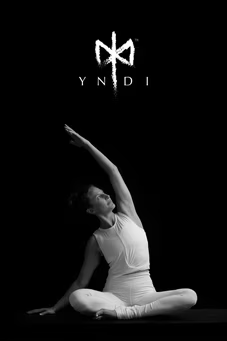
Support for PBS provided by:
Funding for ANTIQUES ROADSHOW is provided by Ancestry and American Cruise Lines. Additional funding is provided by public television viewers.


